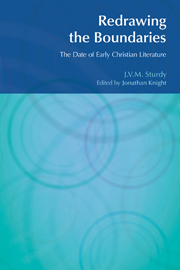Book contents
- Frontmatter
- Contents
- Preface
- Abbreviations
- 1 The Problem Posed
- 2 1 Clement
- 3 The Letters of Ignatius
- 4 Polycarp
- 5 Early Christian Literature: Some Parameters of Date
- 6 The Relationship of the Synoptic Gospels
- 7 Mark
- 8 Luke
- 9 Matthew
- 10 Acts
- 11 The Pauline Corpus: Its Growth and Development
- 12 The Catholic Epistles
- 13 Johannine Literature
- 14 Summary and Conclusions
- Appendix
- Notes
- Bibliography
- Index of Names
- Index of References
4 - Polycarp
- Frontmatter
- Contents
- Preface
- Abbreviations
- 1 The Problem Posed
- 2 1 Clement
- 3 The Letters of Ignatius
- 4 Polycarp
- 5 Early Christian Literature: Some Parameters of Date
- 6 The Relationship of the Synoptic Gospels
- 7 Mark
- 8 Luke
- 9 Matthew
- 10 Acts
- 11 The Pauline Corpus: Its Growth and Development
- 12 The Catholic Epistles
- 13 Johannine Literature
- 14 Summary and Conclusions
- Appendix
- Notes
- Bibliography
- Index of Names
- Index of References
Summary
We come now to the little letter of Polycarp. Ignatius and Polycarp are closely tied up in tradition, and the external evidence of Polycarp is often held to be the strongest support for Ignatian authenticity. But this view can only be held if Polycarp is authentic and uninterpolated. There are, in fact, good reasons for holding that Polycarp, like the Ignatian letters, is pseudepigraphal.
The historical Polycarp was bishop of Smyrna in Asia Minor. He devoted great energy to combating false teachers such as the Marcionites and Valentinians. Towards the end of his life he paid a visit to Rome where he discussed, among other matters, the date of the Easter festival with Bishop Anicetus. It was agreed on that occasion that Asia should continue the Quartodeciman practice.
The date of Polycarp's death is disputed. It is generally held to be 155 CE, but Eusebius puts it in the reign of Marcus Aurelius (161–80). The later date makes it perhaps rather difficult to see Polycarp as a bishop already in 115, especially if Eusebius' chronology is adopted; and still more so in 107 CE (which is when Eusebius says that Ignatius was martyred). I agree with Marrou that Polycarp's death should be placed between 161 and 169, but that it cannot now be determined precisely. The attempt of Grégoire and others to place it as late as 177 CE is generally rejected by the scholarly community.
- Type
- Chapter
- Information
- Redrawing the BoundariesThe Date of Early Christian Literature, pp. 14 - 20Publisher: Acumen PublishingPrint publication year: 2008



